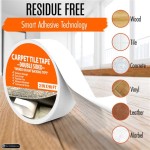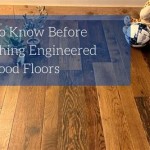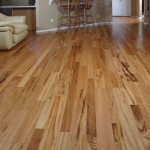How To Replace Water Damaged Floor Joist Boards
Water damage to floor joists can compromise the structural integrity of a building. Whether from leaks, flooding, or condensation, prolonged exposure to moisture can cause wood rot, mold growth, and weakening of the joist, leading to sagging floors and potential safety hazards. Replacing damaged floor joists is a significant undertaking that demands careful planning, proper tools, and a thorough understanding of construction principles. This article provides a detailed guide on how to replace water-damaged floor joist boards.
Before embarking on this project, it is crucial to accurately assess the extent of the damage. Superficial mold or stains may only require treatment, while extensive rot or structural deterioration necessitates replacement. Ignoring early signs of damage can lead to more extensive and costly repairs later. A professional inspection by a structural engineer or experienced contractor is highly recommended to determine the scope of the damage and ensure the repair strategy is adequate. This assessment will also identify any potential underlying causes of the water damage that need to be addressed to prevent recurrence.
Safety is paramount when working on structural repairs. The area being worked on must be properly supported to prevent collapse. Adequate personal protective equipment (PPE), including safety glasses, gloves, and a respirator, should be worn to protect against dust, debris, and potential mold spores. Working with power tools requires caution and adherence to manufacturer's instructions. When in doubt, consult with a qualified professional.
Identifying and Assessing Water Damage
The first step in replacing water-damaged floor joists is to accurately identify and assess the extent of the damage. Visual inspection is the initial method. Warning signs include discoloration, staining, warping, and the presence of mold or mildew. Probing the wood with a screwdriver or awl can reveal soft spots indicative of rot. If the tool penetrates the wood easily, it is a clear sign of significant decay. Pay close attention to areas where joists are in contact with exterior walls, plumbing fixtures, or other potential sources of moisture.
Beyond visual inspection, moisture meters can provide a quantitative assessment of moisture content. Wood should typically have a moisture content below 20%. Readings above this level indicate a potential problem. Infrared cameras can also be used to detect hidden moisture behind walls or under flooring. These tools provide a more comprehensive understanding of the extent of the damage and help to identify areas that may not be immediately visible.
It is crucial to differentiate between cosmetic damage and structural damage. Surface mold can often be cleaned and treated without requiring replacement of the joist. However, if the rot extends deep into the wood, compromising its load-bearing capacity, replacement is necessary. The location of the damage is also a factor. Damage near the center of the joist span is more critical than damage near the ends, where the joist is supported.
Documenting the damage with photographs and detailed notes is essential for planning the repair and for potential insurance claims. These records will provide a clear picture of the damage before, during, and after the repair process. Consulting with a structural engineer or qualified contractor at this stage is highly recommended. They can assess the extent of the damage, advise on the appropriate repair strategy, and ensure that the repair meets local building codes.
Preparing for the Replacement
Once the extent of the damage has been assessed, the next step is to prepare for the replacement process. This involves gathering the necessary tools and materials, providing temporary support for the affected area, and taking precautions to minimize disruption and potential hazards.
The following tools are typically required for replacing floor joists: safety glasses, gloves, respirator, circular saw, reciprocating saw (Sawzall), hammer, pry bar, drill, impact driver, level, measuring tape, wood chisel, and a temporary support system (e.g., adjustable steel posts, lumber for shoring). The specific tools required may vary depending on the complexity of the repair and the type of joist being replaced.
The necessary materials include new lumber for the replacement joists that matches the dimensions and grade of the existing joists. Pressure-treated lumber is recommended for areas prone to moisture exposure. Other materials include construction adhesive, joist hangers, nails, screws, shims, and wood preservative. Ensure that all materials meet local building codes and are suitable for the intended application.
Providing temporary support is crucial to prevent collapse during the replacement process. This can be achieved using adjustable steel posts or by building a temporary support wall using lumber. The support should be positioned on either side of the damaged joist, transferring the load to adjacent joists or to the foundation. Ensure that the support is stable and adequately braced to handle the weight of the structure. It is essential to consult with a structural engineer to determine the appropriate support system for the specific situation.
Before starting the replacement, disconnect any electrical wiring or plumbing that may be running through or near the damaged joists. Take precautions to prevent dust and debris from spreading to other areas of the building. Cover furniture and floors with plastic sheeting, and use a vacuum with a HEPA filter to clean up dust and debris. Clearly mark the work area and restrict access to prevent accidents.
Replacing the Damaged Joist
With the preparation complete, the actual replacement of the damaged joist can begin. This involves removing the damaged section, preparing the area for the new joist, installing the new joist, and securing it properly.
First, carefully remove the damaged section of the joist. Use a reciprocating saw (Sawzall) to cut the joist on either side of the damaged area. The cuts should be made far enough back to ensure that only sound wood remains. If the joist is connected to other structural elements, such as walls or beams, use a pry bar to carefully detach it. Remove any nails or screws that are holding the joist in place. Exercise caution to avoid damaging adjacent joists or other structural components.
Once the damaged section has been removed, inspect the surrounding area for any additional damage or rot. Clean the area thoroughly, removing any debris or loose material. Apply a wood preservative to the exposed ends of the adjacent joists to protect them from moisture and decay. Allow the preservative to dry completely before proceeding.
Next, prepare the new joist for installation. Cut the new joist to the correct length, ensuring that it fits snugly between the adjacent joists or support structures. Use a level to check that the new joist is aligned with the existing joists. Apply construction adhesive to the ends of the new joist to provide a strong bond with the adjacent joists. If using joist hangers, install them according to the manufacturer's instructions.
Carefully position the new joist in place. Use a hammer or impact driver to secure the joist to the adjacent joists or support structures. If using nails, drive them in at an angle to provide greater holding power. If using screws, pre-drill pilot holes to prevent splitting the wood. Use shims to ensure that the joist is level and properly aligned. Once the joist is securely in place, remove the temporary support and inspect the repair to ensure that it is structurally sound.
After the joist is replaced, it is important to address the cause of the water damage. This may involve repairing leaks, improving ventilation, or taking other measures to prevent future moisture buildup. Regularly inspect the area for signs of water damage and address any problems promptly to prevent recurrence.
When replacing floor joists, proper ventilation is crucial. Adequate airflow helps to prevent moisture buildup and reduces the risk of future water damage. Ensure that crawl spaces and basements are adequately ventilated to allow moisture to escape. Consider installing vents or fans to improve air circulation. Regularly inspect ventilation systems to ensure that they are functioning properly.
The information provided in this article is for informational purposes only and should not be considered a substitute for professional advice. Replacing floor joists is a complex and potentially dangerous task that should be undertaken with caution. If unsure about any aspect of the repair process, consult with a qualified structural engineer or contractor.

Fix Replace Damaged Floor Joists How To Sister A Joist

How To Repair Floor Joists With Water Damage Ctr

How To Remove And Replace Rotten Subfloors Diy For Beginners

How To Repair A Butchered Floor Joist Fine Homebuilding

Everything You Need To Know About Floor Joist Repair

How To Repair Floor Joists With Water Damage

Everything You Need To Know About Floor Joist Repair

Mobile Home Subfloor Repair Guide The Dealer Buy And Homes In Florida

Everything You Need To Know About Floor Joist Repair

Wood Damage Dry Rot Repair In Omaha Grand Island Wichita Kansas City Springfield Denver Sioux Thrasher
See Also







